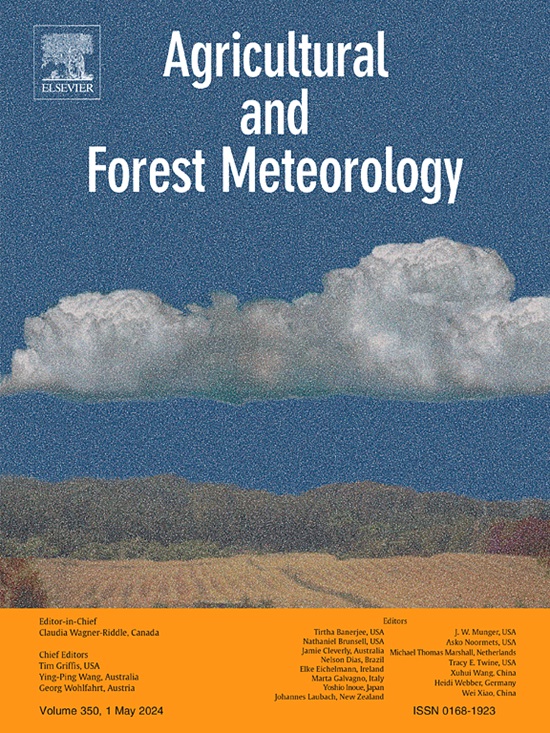2008年中国冰暴后亚热带植被破坏与恢复动态
IF 5.6
1区 农林科学
Q1 AGRONOMY
引用次数: 0
摘要
2008年初,一场极端冰暴袭击了中国南方,包括亚热带广东省,造成了严重的生态破坏和经济损失。以往对该事件中植被损害的评价主要集中在冰造成的即时物理结构损害上,而忽略了极低温胁迫造成的延迟生理损害,特别是在邻近的非冰冻地区。结合遥感数据(MODIS Gross Primary Productivity, GPP)和增强型植被指数(Enhanced Vegetation index, EVI),在考虑时间滞后效应的基础上,对2008年中国冰暴后亚热带植被的破坏与恢复进行了较为全面的评估。我们发现,植被破坏和随后的恢复表现出与冰暴严重程度相关的明显的空间格局。考虑到时滞效应的评估更符合实际情况,表明植被破坏信号通常比事件发生晚1-2个月。在经历二次低温胁迫(没有直接冰暴暴露)的非冻结地区,滞后效应表现出明显的模式。生理损伤在这些区域占主导地位,使GPP降低62%。相比之下,物理结构损伤引起的EVI下降相对较小(51%)。我们还发现冻结时间与植被破坏程度之间存在正相关关系,在冻结程度较低的地区,37%的植被受到破坏,而在严重冻结地区,这一比例为70%。随后GPP和EVI恢复到冰暴前的状态需要4 ~ 9个月,其中GPP恢复速度快于EVI,特别是在严重冰冻森林中。破坏严重程度(或恢复时间)与高程和坡度也存在正相关关系,但在不同的冻结区存在差异。我们的研究结果强调了极端低温胁迫造成的延迟生理损伤,并为极端冰暴后亚热带植被动态提供了新的见解。本文章由计算机程序翻译,如有差异,请以英文原文为准。

Subtropical vegetation damage and recovery dynamics after the great 2008 Chinese ice storm
In early 2008, an extreme ice storm struck southern China, including the subtropical Guangdong Province, causing substantial ecological damage and economic losses. Previous evaluations of vegetation damage during this event primarily focused on the immediate physical structure damage caused by ice, overlooking the delayed physiological damage from extreme low-temperature stress, especially in adjacent non-frozen regions. Combining remotely-sensed (i.e., MODIS Gross Primary Productivity (GPP) and Enhanced Vegetation index (EVI)) and in-situ data, we conducted a more complete assessment of subtropical vegetation damage and recovery following the 2008 Chinese ice storm by considering time-lag effects. We found vegetation damage and subsequent recovery exhibited distinct spatial patterns correlated to ice storm severity. Assessments that accounted for time-lag effects were more aligned with ground truth, revealing that vegetation damage signal typically lagged the event onset by 1–2 months. The time-lag effect showed distinct patterns in non-frozen regions experiencing secondary low-temperature stress (without direct ice storm exposure). Physiological damage dominated these areas, reducing GPP by 62 %. In contrast, physical structural damage caused a comparatively smaller decline (51 %) in EVI. We also found a positive correlation between frozen time and the severity of vegetation damage, with 37 % of vegetation damaged in less frozen zone versus 70 % in severe frozen zone. Subsequent recovery of GPP and EVI to pre-ice storm conditions took 4–9 months, with GPP recovering faster than EVI, especially in severe frozen forests. Such positive correlation also existed between damage severity (or recovery time) and elevation and slope, but the pattern varied across different freezing zones. Our findings highlight the delayed physiological damage from extreme low-temperature stress and provide new insights into subtropical vegetation dynamics following extreme ice storms.
求助全文
通过发布文献求助,成功后即可免费获取论文全文。
去求助
来源期刊
CiteScore
10.30
自引率
9.70%
发文量
415
审稿时长
69 days
期刊介绍:
Agricultural and Forest Meteorology is an international journal for the publication of original articles and reviews on the inter-relationship between meteorology, agriculture, forestry, and natural ecosystems. Emphasis is on basic and applied scientific research relevant to practical problems in the field of plant and soil sciences, ecology and biogeochemistry as affected by weather as well as climate variability and change. Theoretical models should be tested against experimental data. Articles must appeal to an international audience. Special issues devoted to single topics are also published.
Typical topics include canopy micrometeorology (e.g. canopy radiation transfer, turbulence near the ground, evapotranspiration, energy balance, fluxes of trace gases), micrometeorological instrumentation (e.g., sensors for trace gases, flux measurement instruments, radiation measurement techniques), aerobiology (e.g. the dispersion of pollen, spores, insects and pesticides), biometeorology (e.g. the effect of weather and climate on plant distribution, crop yield, water-use efficiency, and plant phenology), forest-fire/weather interactions, and feedbacks from vegetation to weather and the climate system.

 求助内容:
求助内容: 应助结果提醒方式:
应助结果提醒方式:


